Why do cucumber ovaries fall and what to do to save your crop
Cucumbers do not belong to whimsical crops, however, when growing them, gardeners often have problems. It happens that the ovaries turn yellow and begin to fall off, which leads to a sharp decrease in yield. The process can be stopped if the cause is identified in time and adjustments are made to the care measures.
Why cucumber ovaries fall and what to do with this problem, we will tell in the article.
The content of the article
What threatens cucumber ovaries falling off
Newcomers to the dacha business often face the problem of cucumber ovaries falling off. Because of this, the yield is significantly reduced., and in especially neglected situations it is not enough even for summer salads. After the first unsuccessful experience, novice gardeners give up, believing that it is impossible to grow many tasty and aromatic cucumbers on their site.
Important! Do not worry if only a small part of the ovaries turns yellow and falls off - this plant sheds excess load in order to free up resources for the ripening of existing fruits.
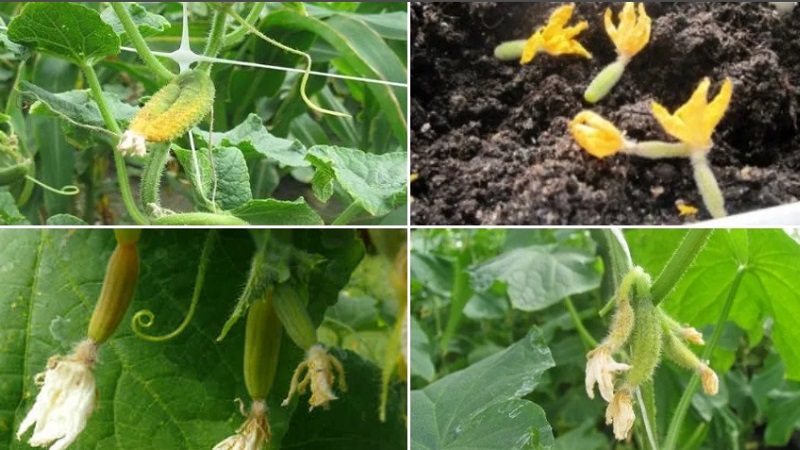
Causes of the problem
There are several reasons that lead to crop loss due to the loss of the ovaries. Let's consider them in more detail.
Planting too dense
So that the ovaries and fruits are formed, it is necessary to give each plant a sufficient amount of light and air... Therefore, the culture is planted taking into account the feeding area of each bush.
Cucumbers are placed in the greenhouse in this way:
- when planting hybrids at 1 m2 do not plant more than two bushes;
- pollinated varieties - 2-3 bushes per 1 m2.
Bushes are not formed
Novice summer residents believe that form bushes cucumbers are impractical, as the yield will decrease. But practice shows that this statement is wrong. The stepsons not only take nutrients and moisture from the main plant, but also prevent new fruits from setting.
Several times during the growing season, remove the lashes on which there are no ovaries... They not only impede air circulation, but also provoke infectious diseases.
All layers formed in the sinuses of the first 3-6 true sheets are completely removed... The stepchildren, who have grown up above, pinch, leaving two leaves on them.
Stems formed in the stepson's sinuses, pinch after the first sheet.
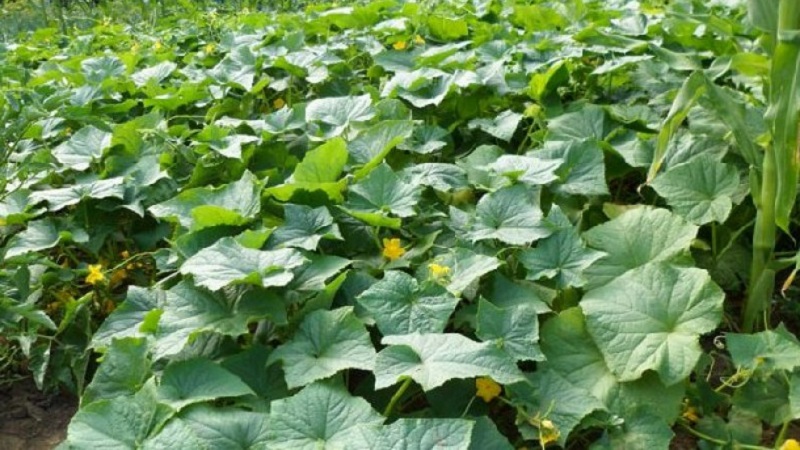
No pollination
All varieties and hybrids, except self-pollinated, need to transfer pollen from male flowers to female flowers. This process is facilitated by insects.To increase the fruiting of each bush, the greenhouse is constantly opened. in the warm time of the day so that the bees fly freely to the plants.
If the summer is rainy, then they resort to hand pollination. This is easy to do: pick a male flower and gently slide it over the pistil of a female one, or use a soft brush to transfer pollen
Variety problems
Before you buy planting material for sowing cucumbers, decide where you will cultivate them. For indoor use, it is better to choose hybrids that do not require insect pollination. – Adam f1, F1 director, Emerald earrings f1, Temp f1.
For open beds, choose low-growing bee-pollinated varieties - they do not require pinching and arranging a large trellis system, small wooden pegs are enough for a garter. The varieties Korotyshka, Kustovoy, Mikrosha, Hector.
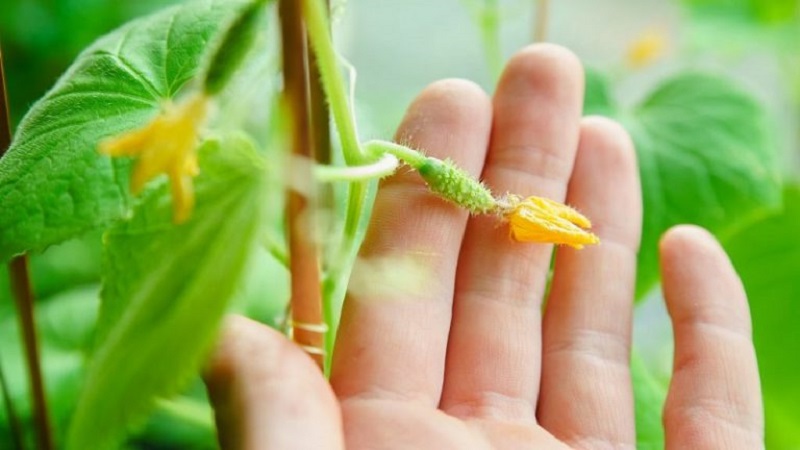
Watering errors
Cucumbers require regular and abundant watering.... If you break irrigation regime, the ovaries will begin to turn yellow and fall off.
Experienced gardeners are advised to strictly follow the rules of watering in the greenhouse:
- use only warm, settled water with a temperature of + 23 ° С - cold liquid not only weakens the plant's immunity, but also reduces the number of female flowers;
- in hot weather, irrigate in the early morning to prevent rapid evaporation of moisture;
- in cool weather, watered during the day, so that the earth would warm up by evening.
Excessive moisture can create a large amount of condensation in the greenhouse., because of which fungal infections will begin to develop, the bushes will hurt, which is fraught with a complete loss of harvest.
Cucumbers are provided with a comfortable moisture level according to the needs of plants at different stages of the growing season:
- before the beginning of the flowering period, the bushes need a lot of moisture, therefore they are watered every seven days, 4 liters per 1 m²;
- as soon as the first flowers appear, watered daily;
- after flowering, cucumbers are watered once every 2-3 days, so that the fruits are poured faster, are juicy and do not taste bitter.

Diseases
Infections provoke rapid yellowing and drying of the ovaries... The most dangerous are bacterioses - they affect weak plants or dense plantings, especially if there are strong temperature changes in the greenhouse.
If the plant looks healthy, but gradually begins to fade from the top - probably root rot. The disease blocks the supply of micronutrients to all parts of the bush, the ovaries quickly fall off.
Unsuitable temperature conditions
Too cold or hot weather can be detrimental to cucumber plantations.... If the crop is grown in a greenhouse, constant ventilation is organized, especially if the weather is hot.
As soon as autumn cold snaps begin, the plantings are insulated. Agrofibre is ideal - it allows plants to breathe and does not provoke condensation.
Why do cucumber ovaries turn yellow in a greenhouse
Yellowing of the ovaries can be triggered by improper farming techniques:
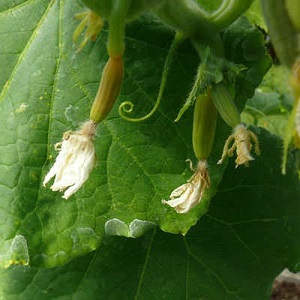 unprepared planting material and soil;
unprepared planting material and soil;- incorrect disembarkation time;
- non-compliance with the distance between the bushes;
- ignoring the formation of bushes.
Dealing with the consequences of a problem is always more difficult than preventing it.... Before planting cucumbers in the greenhouse and during plant growth, preventive measures are taken to help avoid shedding the ovaries:
- choose zoned varieties of cucumbers, that is, the most suitable for growing in a greenhouse in their region;
- have a greenhouse in a sunny area so that the shadow from buildings and trees does not fall on it;
- complex fertilizers are applied to the soil before planting and during flowering;
- strictly adhere to the watering schedule;
- if there are a lot of ovaries, part of them is removed to relieve the plant;
- monitor the temperature regime;
- ripe fruits are collected in a timely manner.
In the open field
Failure to comply with agrotechnical practices when growing cucumbers in open beds leads to yellowing of the ovaries.
There are several reasons:
- untimely harvesting - a large number of ripe fruits signals the plant that it has fulfilled its purpose, and the bush begins to fade;
- strong temperature changes are stress, in which small roots begin to die off, nutrition becomes worse, and ovaries fall from the bushes;
- watering with cold water - the water should be warm and settled;
- not formed bushes - when plantings thicken, plants do not have enough light and fresh air, which provokes the development of diseases and yellowing of the ovaries.
How to save the harvest
To save the harvest identify the cause of wilting and falling of the ovaries.
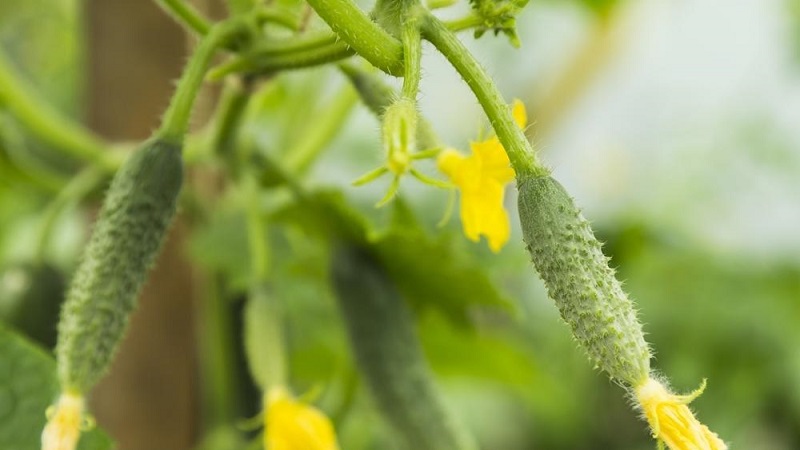
Universal recommendations from experienced gardeners:
- apply a complex of fertilizers - "Ammofosk", "Diammofoska", potassium sulfate are suitable;
- apply folk methods - fertilize with urea and wood ash;
- ensure full pollination of flowers - indoors it can be done manually, outdoors they attract bees;
- remove overgrowing stepsons and form a bush correctly;
- to destroy pests with folk remedies or drugs "Decis", "Inta-vir".
Preventive measures
To avoid problems, carry out preventive measures before landing:
- buy high-quality planting material and carry out seed dressing;
- self-pollinated varieties and hybrids are planted in the greenhouse, since it is difficult for insects to get there;
- think over the landing site - it should be located in an open, lighted area without drafts;
- the location of the beds is changed every year;
- shelter plants in open ground from the scorching sun, equipping a canopy that will save the culture from burns;
- during heavy rains, grooves are dug to drain excess moisture.
Tips & Tricks
Summer residents who have been growing cucumbers for more than one year advise beginners cover your plantings at night with agrofibreto prevent the ovaries from falling off.
The root system of the plant is extensive, therefore when watering, it should be borne in mind that moisture must penetrate deep into the soil not less than 40 cm.
Pay special attention to the seeds.... All experienced gardeners harden them before planting so that they germinate faster, and the seedlings are stronger and more resistant to diseases.
Conclusion
If you do not take action at the first sign of yellowing of the ovaries, there is a risk of losing the entire crop. The reasons for the falling off of the ovaries: diseases, pests, non-compliance with the rules of cultivation. If you follow the recommendations of experienced gardeners, then the fall of the ovaries can be prevented and get a full harvest on time.